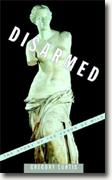Gregory Curtis
book reviews:
· general fiction
· chick lit/romance
· sci-fi/fantasy
· graphic novels
· nonfiction
· audio books
· author interviews
· children's books @
curledupkids.com
· DVD reviews @
curledupdvd.com
newsletter
win books
buy online
links
home
for authors
& publishers
for reviewers

 |
Disarmed: The Story of the Venus de Milo Gregory Curtis Knopf Hardcover 272 pages September 2003 |
|
For less than twenty dollars and a web-surf to Ebay, one can acquire the Louvre’s Venus de Milo—that is, in the form of salt-and-pepper shakers or a bisque decanter. As the Ebay offers indicate, perhaps no other icon of Western art has been slummed into popular culture like this armless archetype. Affirming this notion in his pleasurably written but needlessly comprehensive Disarmed, Texas-based cultural critic Gregory Curtis writes, “The Venus de Milo permeates our culture, where her image is shorthand for lofty ideals.” Even when she is a tchotchke, evidently. But Curtis also clarifies that this sublime contrapposto is the archetype that never was. In reality, the Louvre’s most celebrated statue is likely one of many replicas of an original Venus now lost forever.
While Curtis spills an inordinate amount of ink on the peccadilloes of key nineteenth-century art historians who attempted to answer (or avoid) these very questions, Disarmed’s forte is the author’s reconstruction of the Venus de Milo by means of thorough investigation and general good sense. In due course, Curtis buries a few sorry misconceptions and makes his best guess for this Venus’s true composition—including the vanished portion of her base with the artist’s inscription, the object of her gaze, and the attitude of those lost arms and hands. In his acknowledgments, Curtis reveals that a friend believed his original book proposal—a volume with chapters on single art masterpieces—“sounded more like a series of magazine articles.” Reading Disarmed, one feels that Curtis’s most engaging and on-point content regarding the Venus de Milo would have been best served up as that featured exposé in an art periodical.
|
|
|
|
 Click here to learn more about this month's sponsor! |
|
| fiction · sf/f · comic books · nonfiction · audio newsletter · free book contest · buy books online review index · links · · authors & publishers reviewers |
|
| site by ELBO Computing Resources, Inc. | |
 Curtis’s reminder, however, is not intended to downplay the statue’s brilliance. On the contrary, Disarmed is an overly painstaking justification of the Venus de Milo’s influence, from her discovery in 1821 on the dull island of Melos to her ardent, if misrepresented, promotion by the French to her impact on contemporary art and advertising. More intriguing, though, is Curtis’s mission to confirm the Venus de Milo’s provenance and to resolve a number of enduring mysteries. Namely, was the Venus carved during the classical Greek age, as the French claimed, or the creation of a presumably inferior Hellenist? Was she made by the ideal of Greek sculptors, Phidias, or by some unknown chiseler from Antioch? And what were her missing arms doing?
Curtis’s reminder, however, is not intended to downplay the statue’s brilliance. On the contrary, Disarmed is an overly painstaking justification of the Venus de Milo’s influence, from her discovery in 1821 on the dull island of Melos to her ardent, if misrepresented, promotion by the French to her impact on contemporary art and advertising. More intriguing, though, is Curtis’s mission to confirm the Venus de Milo’s provenance and to resolve a number of enduring mysteries. Namely, was the Venus carved during the classical Greek age, as the French claimed, or the creation of a presumably inferior Hellenist? Was she made by the ideal of Greek sculptors, Phidias, or by some unknown chiseler from Antioch? And what were her missing arms doing?